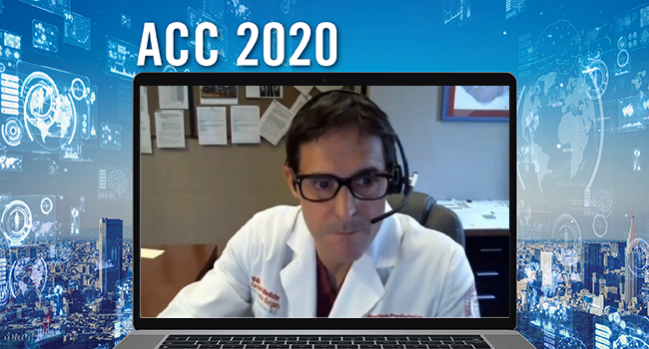Survival Benefit Shown for Radial Artery Grafting in CABG
In a meta-analysis of RCTs, those who received radial grafts rather than saphenous vein grafts had lower mortality at 10 years.

Patients who undergo CABG with a radial artery graft to create the second bypass, as opposed to a saphenous vein graft, appear to have better long-term survival, according to a meta-analysis presented today at the “virtual” American College of Cardiology 2020 Scientific Session.
While prior studies have shown better patency and clinical outcomes with radial artery grafting, Mario Gaudino, MD (Weill Cornell Medicine, New York, NY), said this is the first report based on randomized data to suggest that there may also be a survival benefit.
Compared with a saphenous vein graft, radial CABG was associated with a 27% reduction in the cumulative incidence of death, as well as in the composite of death, MI, and revascularization, at a median of 10 years. Although Gaudino said he felt confident in the results, he acknowledged that the pooled data are not enough to draw a definitive conclusion.
Nevertheless, session moderator Michelle L. O'Donoghue, MD, MPH (Brigham and Women’s Hospital, Boston, MA), called the mortality benefit “intriguing,” and Marc R. Moon, MD (Washington University School of Medicine, St. Louis, MO), said it “brings home the point that the radial artery is better than the saphenous vein graft, in general.”
Likewise, Deepak Bhatt, MD (Brigham and Women’s Hospital), called the findings, which were presented in a late-breaking trial session, “really potentially practice-changing, believable, and consistent with other sorts of observational data sets.”
A Radial Win for Women
For the meta-analysis, Gaudino and colleagues from the RADIAL project analyzed data from five RCTs conducted in Serbia, Australia, the United Kingdom, Italy, and South Korea. Radial artery grafts were used in 534 patients and saphenous vein grafts in 502. The group has previously published 5-year follow up looking at patency and incidence of adverse cardiac events in the same group of patients.
In addition to better survival and a lower primary composite endpoint at 10 years in the radial versus saphenous vein group, Gaudino also reported a lower incidence of the secondary composite outcome of death/MI (HR 0.77; 95% CI 0.63-0.94).
In subgroup analyses, female gender was more strongly associated with better survival with radial artery grafts compared with saphenous vein grafts (HR 0.51; 95% CI 0.36-0.72) than was male gender (HR 0.84; 95% CI 0.68-1.05). In an email, Gaudino said he believes that signal is likely real, noting that “there is a biologic rational, as saphenous vein quality is worse in women.”
The signal in women had previously been seen in the 5-year follow-up, and at that time there also was an association between radial grafts and better outcomes in younger patients. But as Gaudino showed, the association was no longer evident in the 10-year follow-up. To TCTMD, he said there is precedent for this, since the ART trial also showed an age association at 5 years that was gone by 10 years.
Shared Decision-making Goals
For interventionalists well versed with using the radials, the study raises other interesting and important questions, Bhatt noted. He wanted to know if by using radial arteries in PCI, for example, “are we potentially damaging a conduit that you may want to use” at a later time for CABG. Additionally, he wondered if patients in whom a radial graft were used for CABG would require a femoral access if they ever needed repeat catheterization.
“I think the answer, as always, is shared decision-making,” Gaudino said. With two radial arteries available, he noted that interventional cardiologists and surgeons tend to have different points of focus anyway based on their goals. While surgeons prefer the left in most cases because it is easier to harvest the radial artery simultaneously with the left internal thoracic artery, interventional cardiologists typically using the right radial as their first option.
“In general, I think the message is that the [interventional] cardiologists need to be aware of the potential benefits of using the conduits for CABG, and surgeons need to be aware of the advantage of the transradial approach, and then join in shared decision-making,” he added.
Asked about the trend for using radial arteries in CABG in a press conference following Gaudino’s presentation, Frederick Welt, MD (University of Utah Health Sciences, Salt Lake City), said at least at his institution, they tend to be selectively used, typically in younger patients, and represent a minority of surgical approaches. Welt added that given the accumulating data showing the benefits, he hopes to see the practice increase.
“Of course, we’d all like to have a true, single, big, randomized trial, but I don’t know whether that’s in the cards,” he said.
L.A. McKeown is a Senior Medical Journalist for TCTMD, the Section Editor of CV Team Forum, and Senior Medical…
Read Full BioSources
Gaudino M. Radial artery versus saphenous vein for coronary artery bypass surgery at long-term follow-up. Presented on: March 30, 2020. ACC 2020.
Disclosures
- Gaudino reports no relevant conflicts of interest.


Comments